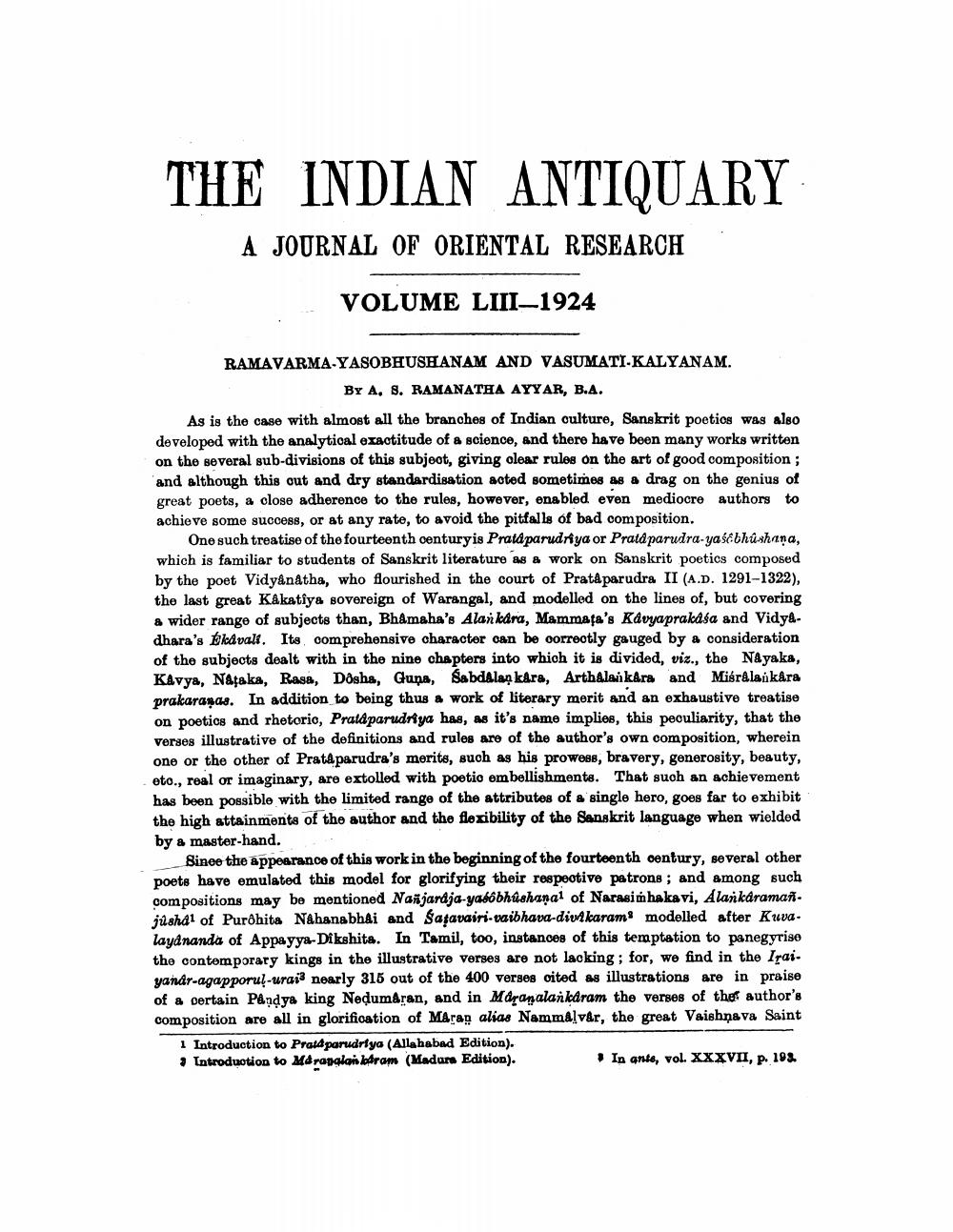Book Title: Indian Antiquary Vol 53 Author(s): Richard Carnac Temple, Stephen Meredyth Edwardes, Krishnaswami Aiyangar Publisher: Swati Publications View full book textPage 7
________________ THE INDIAN ANTIQUARY A JOURNAL OF ORIENTAL RESEARCH VOLUME LIII–1924 RAMAVARMA-YASOBHUSHANAM AND VASUMATI-KALYANAM. BY A, 8. RAMANATHA AYYAR, B.A. As is the case with almost all the branches of Indian culture, Sanskrit poetios was also developed with the analytioal exactitude of & science, and there have been many works written on the several sub-divisions of this subjeot, giving clear rules on the art of good composition; and although this out and dry standardisation acted sometimes as a drag on the genius of great poets, a close adherence to the rules, however, enabled even mediocre authors to achieve some success, or at any rate, to avoid the pitfalls of bad composition. One such treatise of the fourteenth oenturyis Pratd parudriya or Pratd parudra-yaścbhúshana, which is familiar to students of Sanskrit literature as & work on Sanskrit poetics composed by the poet Vidyanatha, who flourished in the court of Prataparudra II (A.D. 1291-1322), the last great Kakatiya sovereign of Warangal, and modelled on the lines of, but covering a wider range of subjects than, Bhamaha's Alankdra, Mammaja's Kavyaprakasa and Vidyadhara's kdvall. Its comprehensive character can be correctly gauged by a consideration of the subjects dealt with in the nine chapters into which it is divided, viz., the Nayaka, Kavya, Nataka, Rasa, Dôsha, Guņa, SabdAlan k&ra, Arthalai kara and Misralar kåra prakaranas. In addition to being thus & work of literary merit and an exhaustive treatise on poetios and rhetorio, Pratdparudriya has, as it's name implies, this peouliarity, that the verses illustrative of the definitions and rules are of the author's own composition, wherein one or the other of Prata parudra's merits, such as his prowess, bravery, generosity, beauty, eto., real or imaginary, are extolled with poetio embellishments. That such an achievement has been possible with the limited range of the attributes of a single hero, goes far to exhibit the high attainments of the author and the flexibility of the Sanskrit language when wielded by a master-hand. Sinee the appearance of this work in the beginning of the fourteenth oentury, several other poets have emulated this model for glorifying their respective patrone ; and among such compositions may be mentioned Nasjardja-yashbhushanal of Narasimhakavi, Alankaraman. ushal of Purðhita Nahanabhai and Satavairi-vaibhava-div karame modelled after Kuva. layananda of Appayya Dikshita. In Tamil, too, instances of this temptation to panegyrise the contemporary kings in the illustrative verses are not lacking; for, we find in the Irai. yandr-agapporul-urais nearly 315 out of the 400 verses oited as illustrations are in praise of a certain Pandya king Nedumaran, and in Mdyanalankdram the verses of the author's composition are all in glorification of Maran alias Nammalvar, the great Vaishnava Saint 1 Introduction to Prata parudriya (Allahabad Edition). Introduotion to Marapalan baram (Madars Edition). • In ante, vol. XXXVII, p. 19%Page Navigation
1 ... 5 6 7 8 9 10 11 12 13 14 15 16 17 18 19 20 21 22 23 24 25 26 27 28 29 30 31 32 33 34 35 36 37 38 39 40 41 42 43 44 45 46 47 48 49 50 51 52 53 54 55 56 57 58 59 60 61 62 63 64 65 66 67 68 69 70 71 72 ... 392
